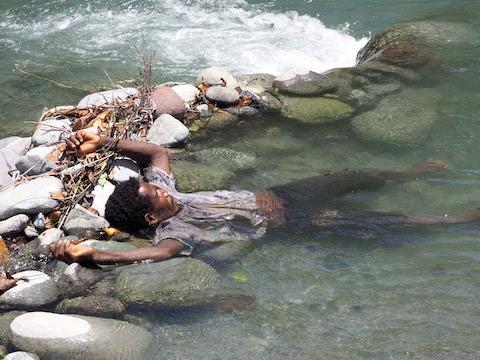Preparing for disaster in the Solomon Islands: A community response

The third warning siren sounds and the villagers begin to run. They are moving to higher ground away from rising floodwater. However, there is no flood today. Here in Koleasi, an isolated region south of Solomon Islands’ capital, the villagers are carrying out a disaster simulation. The aim is to show how they would respond in the event of a real disaster.
Around 62 families live here, close to 300 people, of which well over half are children. The houses are built along the banks of the Koleasi River, south of Honiara. Flooding is common to the region and the Koleasi people are familiar with the ebb and flow of their river.
In April 2014, during several days of heavy rain the Koleasi River burst its banks causing a severe flash flood that destroyed village crops and swept away homes.
“Four families including me lost their homes in the flood,” says David Rex a father of eight.
“My house is a semi-permanent home, it was washed away by the flood, I mean I lost everything,” he says.
After the floods, World Vision saw a need for better disaster resilience in these remote areas. With UNDP funding, they set up a project to help 20 communities develop a Disaster Risk Reduction plan. The aim was to prepare the communities for a natural disaster and to help them develop the skills to respond quickly and efficiently when the need arose.
The disaster simulation is an effort to measure the effectiveness of the plan. Everyone in village is involved from the smallest children to the oldest adults.
The simulation begins with three warning sirens, using conch shells and a loud hailer. On the third alert, the villagers begin moving swiftly up the hill towards the safe house. There they gather under shelter, build a fire and begin to treat the sick and injured, while they try to contact help via radio.
As part of the simulation plan, not everyone has been able to get away. As soon as it is considered safe, a rescue team go back to the village to check for survivors. There they find Erica, a young girl who has broken her leg, and a small boy called Bradley who has a broken arm. The medical team tend to the victims, using first aid skills they have learnt as part of their DRR plan.
The simulation even includes some deaths. Down at the river they find two men and a small boy lying in the water. The nurse checks the body for signs of life and determines that the have drowned. Their bodies are carried back to the village where they are prepared for burial.
“Since the disaster plan I have learnt new things and I feel secure because it has given me new ideas and new ways of doing things,” says David Rex.